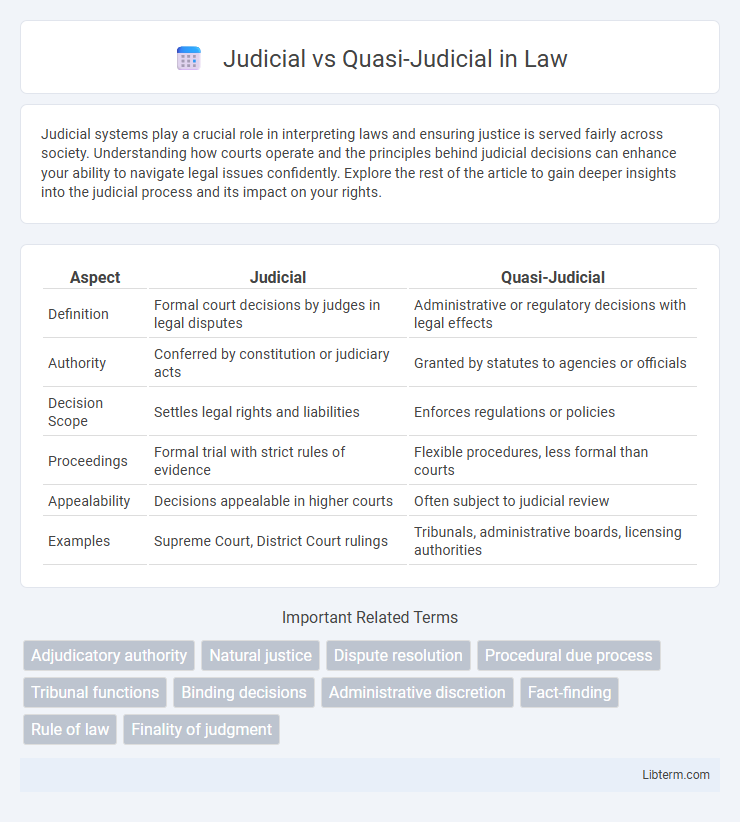Judicial systems play a crucial role in interpreting laws and ensuring justice is served fairly across society. Understanding how courts operate and the principles behind judicial decisions can enhance your ability to navigate legal issues confidently. Explore the rest of the article to gain deeper insights into the judicial process and its impact on your rights.
Table of Comparison
| Aspect | Judicial | Quasi-Judicial |
|---|---|---|
| Definition | Formal court decisions by judges in legal disputes | Administrative or regulatory decisions with legal effects |
| Authority | Conferred by constitution or judiciary acts | Granted by statutes to agencies or officials |
| Decision Scope | Settles legal rights and liabilities | Enforces regulations or policies |
| Proceedings | Formal trial with strict rules of evidence | Flexible procedures, less formal than courts |
| Appealability | Decisions appealable in higher courts | Often subject to judicial review |
| Examples | Supreme Court, District Court rulings | Tribunals, administrative boards, licensing authorities |
Introduction to Judicial and Quasi-Judicial Authorities
Judicial authorities refer to courts and judges empowered to interpret laws, adjudicate disputes, and deliver binding legal judgments in civil and criminal cases. Quasi-judicial authorities are administrative bodies or officials granted limited powers to adjudicate specific issues, making decisions that affect individual rights but often subject to judicial review. Both judicial and quasi-judicial entities play crucial roles in the legal system by ensuring accountability, enforcing laws, and resolving conflicts within their jurisdiction.
Defining Judicial Functions
Judicial functions involve the interpretation and application of laws by courts through formal legal proceedings to resolve disputes, enforce rights, and administer justice. Quasi-judicial functions are performed by administrative or regulatory agencies that have authority to adjudicate specific matters, make decisions, and impose penalties, but do not operate with the full judicial powers of courts. The key distinction lies in the formal judicial authority, procedural safeguards, and scope of power exercised during the decision-making process.
Understanding Quasi-Judicial Functions
Quasi-judicial functions involve decisions made by administrative or executive agencies that resemble judicial rulings but do not have full judicial authority. These functions include investigating facts, interpreting laws, and adjudicating disputes within a specialized domain, such as regulatory boards or tribunals. Unlike judicial bodies, quasi-judicial authorities operate with more flexible procedures but must maintain fairness, impartiality, and adherence to due process standards.
Key Differences Between Judicial and Quasi-Judicial Bodies
Judicial bodies possess the authority to interpret laws and deliver binding verdicts in court cases, whereas quasi-judicial bodies primarily adjudicate disputes through administrative procedures without full judicial powers. Judicial bodies strictly follow procedural laws and rules of evidence, while quasi-judicial bodies operate with more flexibility, balancing fairness and efficiency. Key differences also include the nature of authority, with judicial bodies deriving power from constitutional or statutory sources, contrasted by quasi-judicial entities empowered by regulatory statutes to enforce specific administrative regulations.
Legal Framework Governing Judicial and Quasi-Judicial Roles
The legal framework governing judicial roles is primarily established by statutes and constitutional provisions that define the powers, jurisdiction, and procedures of courts to ensure impartial adjudication of disputes. Quasi-judicial roles operate under administrative laws and specific enabling statutes that grant government agencies or administrative bodies authority to make decisions resembling judicial determinations on regulatory or disciplinary matters. Both frameworks emphasize the principles of natural justice, such as the right to a fair hearing and unbiased decision-making, but judicial roles strictly adhere to formal court procedures, whereas quasi-judicial functions allow for more flexible procedures tailored to administrative efficiency.
Powers and Limitations of Judicial Authorities
Judicial authorities possess the power to adjudicate disputes, interpret laws, and enforce legal rights through binding decisions subject to appeal in higher courts. Their limitations include adherence to established legal procedures, jurisdictional boundaries, and the necessity to base rulings solely on evidence and legal principles without executive influence. Quasi-judicial bodies exercise limited judicial functions such as fact-finding and decision-making but lack comprehensive judicial authority, often confined to administrative scope with decisions subject to judicial review.
Scope and Jurisdiction of Quasi-Judicial Bodies
Quasi-judicial bodies possess limited jurisdiction, primarily confined to specific sectors such as administrative, regulatory, or disciplinary matters, differing from full judicial courts with broad authority. Their scope is defined by enabling statutes or regulations, granting powers to adjudicate disputes, conduct hearings, and issue orders with binding effects within their specialized domain. These bodies facilitate expedited dispute resolution by applying principles of natural justice, ensuring procedural fairness without the formalities typical of judicial courts.
Examples of Judicial Institutions
Judicial institutions include the Supreme Court, High Courts, and district courts, which have the authority to interpret laws and deliver binding verdicts in legal disputes. These bodies handle civil, criminal, and constitutional cases with formal procedures and adherence to legal precedents. Courts like the International Court of Justice and appellate courts also represent examples of judicial institutions that exercise adjudicatory powers within their jurisdictions.
Examples of Quasi-Judicial Authorities
Quasi-judicial authorities include administrative agencies, tribunals, and commissions that possess the power to interpret laws, adjudicate disputes, and enforce regulations without being courts. Examples include the Securities and Exchange Board of India (SEBI), which regulates financial markets, the National Human Rights Commission (NHRC), which addresses human rights violations, and labor tribunals that resolve employment disputes. These bodies conduct hearings, examine evidence, and issue decisions binding on parties, blending administrative functions with judicial processes.
Impact and Importance in the Legal System
Judicial bodies deliver binding decisions that establish legal precedents essential for maintaining rule of law and ensuring justice through formal court procedures. Quasi-judicial authorities, such as administrative tribunals, resolve disputes with specialized expertise, offering faster and more accessible adjudication, thus alleviating court caseloads. The complementary impact of both enhances legal efficiency, accountability, and public confidence within the justice system.
Judicial Infographic

 libterm.com
libterm.com